In this article
Activated charcoal is often presented as a miracle substance, but its true value for a prepared hiker lies in understanding its specific, scientifically proven applications. Let’s move past the hype. This is not the same as the common charcoal briquettes from your campfire grill or fireplace; this is a high-tech material, an engineered piece of gear with a microporous structure. Hikers constantly deal with uncertain water quality, potential emergencies, and gear hygiene at the campsite. This guide offers an evidence-based look at how to use activated charcoal safely and effectively. We will show you where it excels—in chemical filtration, specific first-aid uses, and odor control—and, critically, where it fails, to ensure your preparedness on the trail, making it perfect for backpacking, hiking, camping.
Water Treatment: The Chemical Guardian, Not the Pathogen Purifier
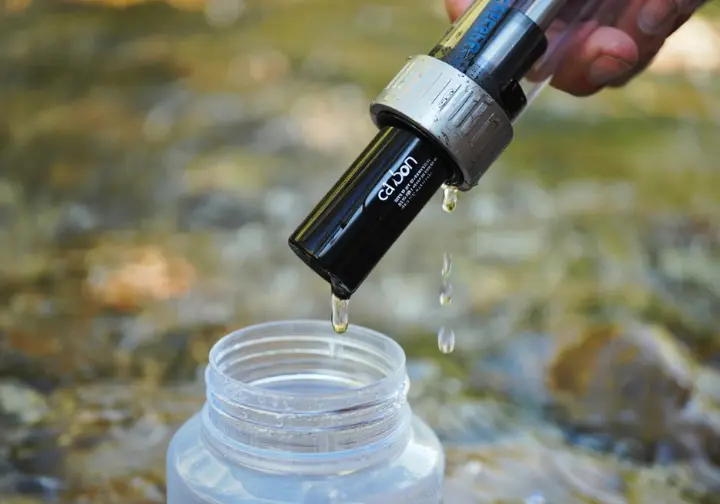
This material’s main role in a hiker’s water treatment system is to improve taste, odor, and chemical safety. It is not, however, a standalone solution for making water microbiologically safe to drink. A clear understanding of this distinction is fundamental to staying healthy in the backcountry during any camping trip.
How Adsorption Makes Your Water Taste Better
Activated charcoal works through adsorption, a process where contaminant molecules stick to its incredibly vast internal surface. This is different from absorption, which is how a sponge soaks up water. A single gram of activated carbon can have a surface area of over 1,000 square meters, offering a huge number of binding sites. The material’s porous texture has a slight negative charge that attracts and holds many positively charged chemical molecules, like chlorine and volatile organic compounds (VOCs).
The primary benefit for hikers is a major improvement in water palatability. This porous charcoal excels at adsorbing the dissolved organic compounds that give backcountry water a swampy taste and smell, making hydration a more pleasant experience. Many [activated carbon and charcoal FAQs] detail this specific chemical process. To see how this technology is used in various devices, explore our comprehensive guide to water filters and purifiers.
What Activated Carbon Reliably Removes from Water
The strength of activated carbon filters is removing a specific class of chemical contaminants. This is particularly important when sourcing water near agricultural or industrial areas. It is highly effective against common pesticides, herbicides, and industrial solvents like benzene. The simple truth is that carbon adsorbs chemicals. It also removes chlorine, often used in front-country water sources, and the byproducts of chlorination like trihalomethanes (THMs).
In most quality hiking filters, the activated carbon module is a secondary stage. It typically follows a primary microfilter, like a hollow fiber element, that removes larger pathogens. The carbon portion then “polishes” the water, adsorbing chemicals and off-tastes the first stage missed. This is why you’ll often find a carbon element in a good travel water bottle with a built-in filter. The effectiveness of drinking water treatment with activated carbon is well-documented for these specific compounds.
CRITICAL SAFETY: What Activated Carbon Does NOT Remove
This is the most critical point for hiker safety: standard activated carbon isn’t effective at removing microbiological pathogens. It will not remove bacteria like E. coli, protozoa like Giardia, or viruses like Norovirus. The pores are too large to block these organisms. It also does not remove dissolved minerals, salts, or metals, meaning it cannot desalinate water or remove fluoride and nitrates. While some specialized filters use ion-exchange microbeads to reduce certain heavy metals, a standard carbon filter should not be relied upon for this.
To make water fully safe, you must use a combined approach. Pair an activated carbon element with a primary purification method, such as a mechanical filter (0.2-micron pore size for bacteria/protozoa) and a purifier (UV or chemical) for viruses, which must pass a strict EPA registration process. It’s vital to understand The difference between a water filter and a purifier to make safe choices. For any international travel, always consult official water disinfection guidelines for travelers. This limitation is also a key point when using activated carbon filters for home drinking water.
The Hidden Danger: Understanding Filter Lifespan and Failure
An activated carbon filter has a finite lifespan. Once all the binding sites on its surface are full, it becomes saturated and stops working. The greatest risk is that there is no obvious sign of failure. Unlike a mechanical filter that clogs and becomes hard to use, a saturated carbon filter lets water flow freely. You will have no way of knowing it is no longer protecting you from chemicals, creating a false sense of security during car camping or a long trek.
In combination filters, the carbon element almost always has a shorter lifespan than the mechanical part. A filter might be rated for 100,000 gallons, but its carbon component may only last for 150 gallons. Thru-hikers must track their water usage meticulously. Filter performance is also reduced in very cold water and works best with a slower flow rate to increase contact time. This is why tracking its use is a critical habit for maintaining reliable must-have backpacking gear. Many manufacturers highlight the limitations of activated carbon in water treatment for this reason.
Trailside First Aid: An Emergency Tool for Specific Situations
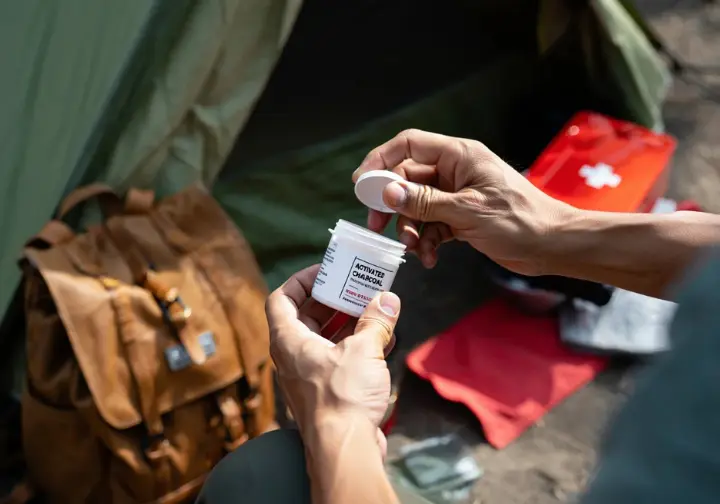
When used responsibly, activated charcoal can be a valuable part of a first-aid kit. This section provides evidence-based guidance on its medical applications, focusing on its role in specific poisoning emergencies and clarifying common myths, with a strong emphasis on safety.
The Primary Medical Use: Ingested Toxins and Poisoning
When swallowed, activated charcoal adsorbs a wide range of drugs and toxins in the digestive tract, preventing them from entering the bloodstream. Its effectiveness is extremely time-dependent; medical guidelines state it should be given as soon as possible, ideally within one hour of ingesting a toxin. For some substances, it can also interrupt recirculation, a process where toxins are reabsorbed by the body, enhancing their elimination.
The standard clinical dose is 1 gram per kilogram of body weight, mixed into a slurry with water. The proper clinical use of activated charcoal is highly specific. Medical studies on using activated charcoal to treat intoxications confirm its efficacy when used correctly. Knowing its place in a well-stocked first-aid kit as part of the Ten Essentials is what matters, making it a key item in any emergency kit.
When NOT to Use Charcoal: Critical Contraindications
Activated charcoal does not adsorb everything. It is ineffective for corrosives like strong acids, hydrocarbons like gasoline, alcohols, and heavy metals like iron or lithium. It should never be given to someone who is drowsy or has a depressed level of consciousness due to the high risk of inhaling the slurry into the lungs, which can be life-threatening. It is also contraindicated for anyone with a bowel obstruction or perforation.
In any suspected poisoning, the first and most critical step is to contact a Poison Control Center or emergency services if possible. They will provide specific guidance. Knowing when not to use a tool is one of the most essential hiking beginner tips for staying safe. A full profile of the benefits, uses, and side effects of activated charcoal includes knowing these risks, which is why a comprehensive survival kit includes knowledge, not just supplies.
Folk Remedies vs. Facts: Topical Use for Bites and Stings
A popular claim suggests using a topical paste of activated charcoal as a “drawing salve” for insect bites and stings. The theory is that it can pull venom or irritants from the skin. While this idea seems plausible, this use is a folk remedy and is not supported by rigorous clinical evidence. It may offer minor relief from itching for non-venomous bites, but its effectiveness is unproven.
This folk remedy should never replace proper medical care for venomous bites from spiders or snakes. It is also not a treatment for severe allergic reactions (anaphylaxis), which require immediate medical attention. Deciding what folk remedies to leave out is part of building a complete set of hiking equipment for beginners. A look at the science behind activated charcoal uses shows no strong support for this topical application.
Activated Charcoal Camping Hygiene: Winning the Battle Against Odor
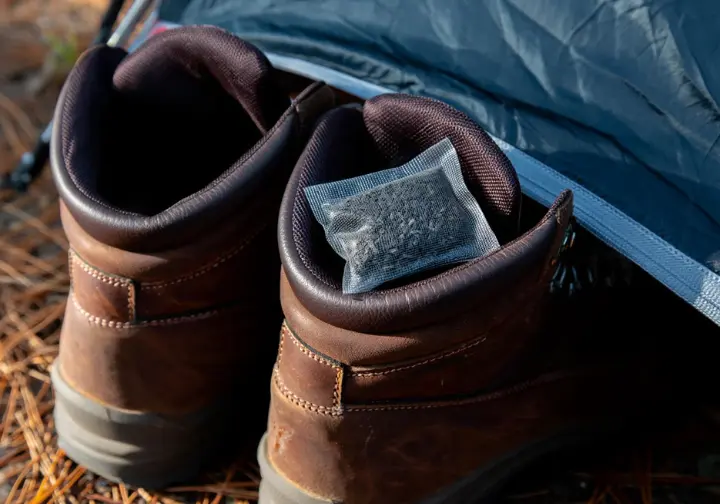
Beyond water and first aid, one of the most practical and low-risk applications of activated charcoal camping is managing odors. This simple use can greatly enhance comfort on multi-day treks by keeping your gear and campsite fresher, whether you’re backpacking or enjoying a picnic.
How Charcoal Traps Unwanted Odors in Your Gear
The unpleasant smells from sweaty boots and dirty laundry come from airborne volatile organic compounds (VOCs) produced by bacteria. The principle of adsorption works on these gas molecules just as it does on liquid contaminants. The charcoal’s porous surface creates effective charcoal traps for these odor-causing VOCs, neutralizing the smell at its source rather than just masking it like smoke from a camp smoker.
This science is so effective that it is a cornerstone of the scent-control industry for hunting, where activated carbon is used to trap human scent. The application of activated carbon in odor control is a well-established science, making it one of the most useful hygiene hacks for your packing list on a multi-day trip.
Practical Applications for a Fresher Campsite
One of the best uses is placing small charcoal sachets inside your hiking boots overnight. This will significantly reduce odor buildup, making tent life much more pleasant for everyone, especially on a long car camping trip. A larger pouch can be placed inside your dirty clothes sack to keep smells contained and away from your clean gear and food supplies. For some specialized gear, the adsorptive capacity can even be renewed. Placing a carbon-lined garment in a high-heat dryer can release trapped odor molecules, “reactivating” it for your next trip.
Managing odor is a key part of learning how to pack a hiking backpack efficiently for longer treks. These simple tricks are some of the most practical activated charcoal uses for survival and comfort on the trail.
The Survivalist’s Guide: Making and Using DIY Charcoal
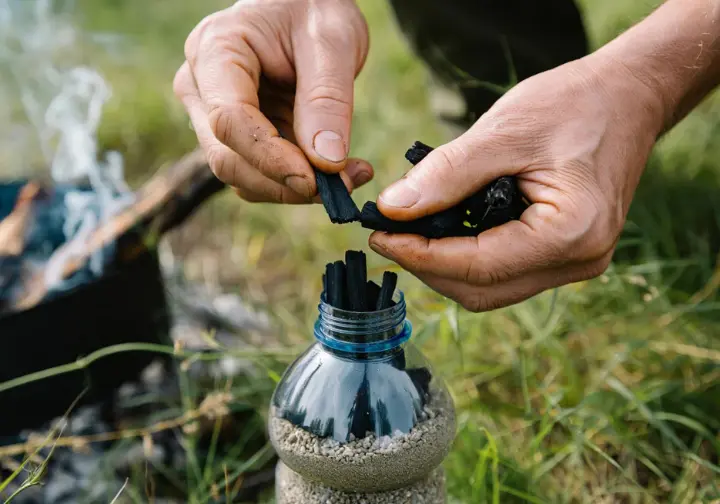
For those interested in self-sufficiency, making your own charcoal is a classic skill. However, it’s a skill that must be framed with a heavy dose of realism and critical safety warnings about the severe limitations of any homemade equipment you might use at your camp.
How to Make Basic Charcoal in a Survival Scenario
The first step is to create simple char from hardwood through pyrolysis—heating organic material in a low-oxygen environment. The “two can” method is a common technique. You place small pieces of dense hardwood, not unlike hardwood lump charcoals, inside a small metal tin with a tiny hole in the lid. This tin is then placed inside a larger can and heated in a fire for several hours. The hole lets volatile gases escape without letting enough oxygen in for the wood to burn.
The process is finished when smoke stops venting from the small hole. After it has cooled completely, the contents will be a lightweight, black charcoal blend, ready for use as a great outdoor fire tool. This skill is a big step in transitioning from day hiker to self-sufficient backpacker. There are detailed online guides explaining how to make activated charcoal correctly with this method.
The Reality of DIY Filters: A Tool for Clarity, Not Safety
A basic survival filter can be made from a plastic bottle cut in half and turned upside down. You then add layers from bottom to top: a cloth barrier, fine sand, your crushed charcoal, more sand, and finally coarse gravel to strain large debris. This layered filter can improve the clarity of murky water by removing sediment and silt. The charcoal layer may also adsorb some chemical impurities and slightly improve the taste of water used for camping food like freeze-dried meals.
CRITICAL SAFETY: A homemade filter is completely unreliable for removing microbiological pathogens. It will not stop bacteria, protozoa, or viruses. Relying on it for purification is dangerous and can lead to severe illness. Any water from a DIY filter must be disinfected before drinking, either by boiling for at least one minute on an outdoor stove or by using chemical purification tablets. Understanding these limitations is part of the true self-reliance needed for surviving in the wilderness. An EPA fact sheet on water filters further clarifies these important distinctions.
Conclusion: Activated Charcoal’s True Role in Your Hiking System
The most important takeaway is to see activated charcoal as a specialized tool, not a panacea. It’s a powerful ally when you apply its strengths correctly and respect its weaknesses.
In your water system, its role is to enhance, not purify. It works with a primary filter or purifier to make water safer from chemicals and better tasting. In your first-aid kit, it’s a specific tool for a narrow set of poisoning events, used with full knowledge of its contraindications. For gear hygiene, it’s a simple comfort item. In a survival situation, it helps clarify water that must still be disinfected. Good storage of all your supplies is key to preparedness.
By understanding both the power and the limits of activated charcoal, you move from myth to true preparedness. This expert knowledge lets you integrate it into your gear confidently and safely.
Frequently Asked Questions about Activated Charcoal Camping
What’s the real difference between activated charcoal and the charcoal from my campfire? +
How can I tell when the carbon filter in my water filter is used up? +
Can I use activated charcoal to treat diarrhea from bad food on a hike? +
In what poisoning situations would using activated charcoal be dangerous? +
We are a participant in the Amazon Services LLC Associates Program, an affiliate advertising program designed to provide a means for sites to earn advertising fees by advertising and linking to Amazon.com. As an Amazon Associate I earn from qualifying purchases. We also participate in other affiliate programs. The information provided on this website is provided for entertainment purposes only. We make no representations or warranties of any kind, expressed or implied, about the completeness, accuracy, adequacy, legality, usefulness, reliability, suitability, or availability of the information, or about anything else. Any reliance you place on the information is therefore strictly at your own risk. Additional terms are found in the terms of service.



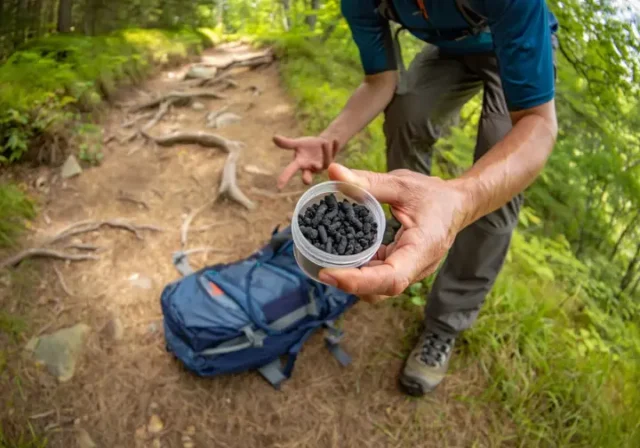





![Trek Budgeting: A Data-Backed Guide [+ Free Template] A trekker sits at a desk planning a trip budget on a laptop, with a stunning view of the Himalayan mountains visible through a window behind them.](https://thehikingtribe.com/wp-content/uploads/2025/07/00-trek-budgeting-data-backed-planning-100x75.webp)

